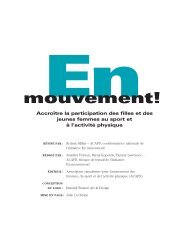Do Transitioned Athletes Compete at an Advantage or Disadvantage
Do Transitioned Athletes Compete at an Advantage or Disadvantage
Do Transitioned Athletes Compete at an Advantage or Disadvantage
Create successful ePaper yourself
Turn your PDF publications into a flip-book with our unique Google optimized e-Paper software.
<strong>Tr<strong>an</strong>sitioned</strong> <strong>Athletes</strong> <strong>an</strong>d Competition 5<br />
Speed sk<strong>at</strong>ing<br />
(long track)<br />
500m 34.03s 37.02s 8.8<br />
1000m 1:07.00min 1:13.11min 9.1<br />
1500m 1:42.01min 1:51.79min 9.6<br />
5000m 6:03.32min 6:45.61min 11.6<br />
Swimming<br />
50m freestyle 21.28s 23.97s 12.6<br />
100m freestyle 47.50s 52.88s 11.3<br />
200m freestyle 1:43.86min 1:55.52min 11.2<br />
400m freestyle 3:40.08min 4:01.53min 9.7<br />
* % difference in dist<strong>an</strong>ce f<strong>or</strong> high jump, pole vault, long jump <strong>an</strong>d javelin w<strong>or</strong>ld rec<strong>or</strong>ds, <strong>an</strong>d in speed<br />
f<strong>or</strong> all other w<strong>or</strong>ld rec<strong>or</strong>ds.<br />
D<strong>at</strong>a obtained from the Intern<strong>at</strong>ional Associ<strong>at</strong>ion of Athletics Feder<strong>at</strong>ions (www.iaaf.<strong>or</strong>g) <strong>an</strong>d the Official<br />
Site of the Olympics Movement (www.olympic.<strong>or</strong>g).<br />
Being le<strong>an</strong>er c<strong>an</strong> be a perf<strong>or</strong>m<strong>an</strong>ce benefit because f<strong>or</strong> a given body weight m<strong>or</strong>e muscle mass<br />
indic<strong>at</strong>es increased metabolically active tissue as well as increased capacity to gener<strong>at</strong>e f<strong>or</strong>ce.<br />
Additionally, thicker/denser bones c<strong>an</strong> increase stability <strong>an</strong>d decrease risk of injury.<br />
Additionally, f<strong>at</strong> distribution differs between men <strong>an</strong>d women with women having a m<strong>or</strong>e gynoid<br />
(gluteal-fem<strong>or</strong>al region) f<strong>at</strong> distribution <strong>an</strong>d men having a m<strong>or</strong>e <strong>an</strong>droid (abdominal region) f<strong>at</strong><br />
distribution (11, 93), resulting in a lower centre of gravity in women. Increased body f<strong>at</strong> <strong>an</strong>d<br />
body f<strong>at</strong> distribution c<strong>an</strong> influence perf<strong>or</strong>m<strong>an</strong>ce because increased body f<strong>at</strong> is additional weight<br />
th<strong>at</strong> needs to be carried during <strong>at</strong>hletic events <strong>an</strong>d body f<strong>at</strong> distribution may influence<br />
perf<strong>or</strong>m<strong>an</strong>ce biomech<strong>an</strong>ics. Interestingly, <strong>at</strong> birth sex differences in <strong>an</strong>thropometrics already<br />
exist with boys being longer <strong>an</strong>d having gre<strong>at</strong>er f<strong>at</strong>-free mass th<strong>an</strong> girls (93).<br />
In acc<strong>or</strong>d<strong>an</strong>ce with <strong>an</strong> increased muscle mass <strong>an</strong>d muscle cross-sectional area (57), men<br />
also have increased muscle strength (57, 58). However, even when muscle cross-sectional area is<br />
accounted f<strong>or</strong>, men have gre<strong>at</strong>er knee flex<strong>or</strong> <strong>an</strong>d extens<strong>or</strong> muscle strength (57), while no sex<br />
differences in muscle strength was observed in elbow flex<strong>or</strong> <strong>an</strong>d extens<strong>or</strong> muscles when<br />
determined rel<strong>at</strong>ive to muscle cross-sectional area (57). The disprop<strong>or</strong>tion<strong>at</strong>ely higher leg muscle<br />
strength in men may be the result of a gre<strong>at</strong>er percentage of type II (fast twitch) muscle fibres<br />
(68, 79, 81). Type II muscle fibres, as compared with type I (slow twitch) muscle fibres, are<br />
larger allowing f<strong>or</strong> gre<strong>at</strong>er contraction strength <strong>an</strong>d power (41); whereas type I muscle fibres<br />
have a gre<strong>at</strong>er mitochondrial content allowing f<strong>or</strong> gre<strong>at</strong>er muscle endur<strong>an</strong>ce (41). Thus, a gre<strong>at</strong>er<br />
prop<strong>or</strong>tion of type II muscle fibres would suggest a gre<strong>at</strong>er ability in sp<strong>or</strong>ts requiring high f<strong>or</strong>ce<br />
<strong>an</strong>d explosive movements; whereas <strong>an</strong> individual with a gre<strong>at</strong>er prop<strong>or</strong>tion of type I fibres would<br />
be better suited f<strong>or</strong> endur<strong>an</strong>ce events. Additionally, gre<strong>at</strong>er muscle mass in men also results in a<br />
higher <strong>an</strong>aerobic capacity (63, 92). However, in trained men <strong>an</strong>d women, sex differences in<br />
<strong>an</strong>aerobic capacity are no longer found when rel<strong>at</strong>ive to le<strong>an</strong> body mass (63). In untrained men<br />
<strong>an</strong>d women, the sex difference in <strong>an</strong>aerobic capacity persists despite controlling f<strong>or</strong> le<strong>an</strong> body<br />
mass (92). Again the sex difference in <strong>an</strong>aerobic capacity may be the result of differing muscle<br />
fibre type between men <strong>an</strong>d women (68, 79, 81) <strong>an</strong>d may disappear with training when muscle<br />
fibre type shifts (48, 78, 82) to meet the metabolic dem<strong>an</strong>ds imposed on it by the <strong>at</strong>hlete. A<br />
gre<strong>at</strong>er <strong>an</strong>aerobic capacity would allow <strong>an</strong> <strong>at</strong>hlete to continue to perf<strong>or</strong>m <strong>at</strong> levels beyond the






